MGT501 - Business Environment: Detailed Stakeholder Analysis Report
VerifiedAdded on 2022/10/12
|17
|3740
|376
Report
AI Summary
This report provides a comprehensive analysis of internal and external stakeholders within the context of the business environment, using Woolworths as a case study. It begins with an executive summary and introduction, followed by an examination of functional areas within a business, including marketing, human resources, finance, operations, and customer service. The report then defines and categorizes stakeholders into internal (employees, shareholders) and external (customers, suppliers, government) groups, exploring the nature and degree of their interests. It delves into stakeholder theory, discussing its implications and applying it to Woolworths. A stakeholder analysis matrix is used to assess the level of influence and interest of different stakeholders. The report also includes a stakeholder comparative analysis, a discussion of conflicting interests, and concludes with key findings and recommendations. References are provided to support the analysis.
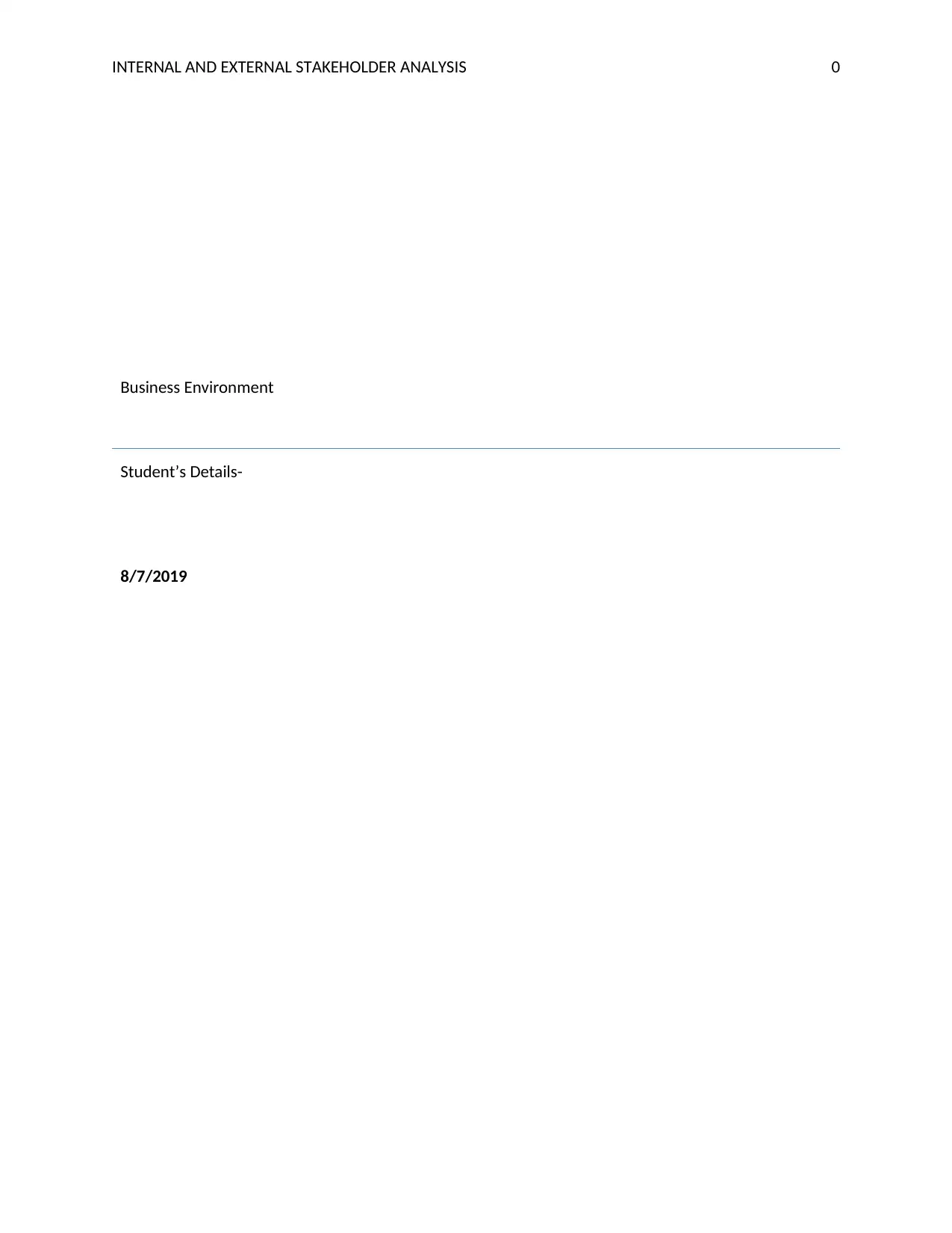
INTERNAL AND EXTERNAL STAKEHOLDER ANALYSIS 0
Business Environment
Student’s Details-
8/7/2019
Business Environment
Student’s Details-
8/7/2019
Paraphrase This Document
Need a fresh take? Get an instant paraphrase of this document with our AI Paraphraser
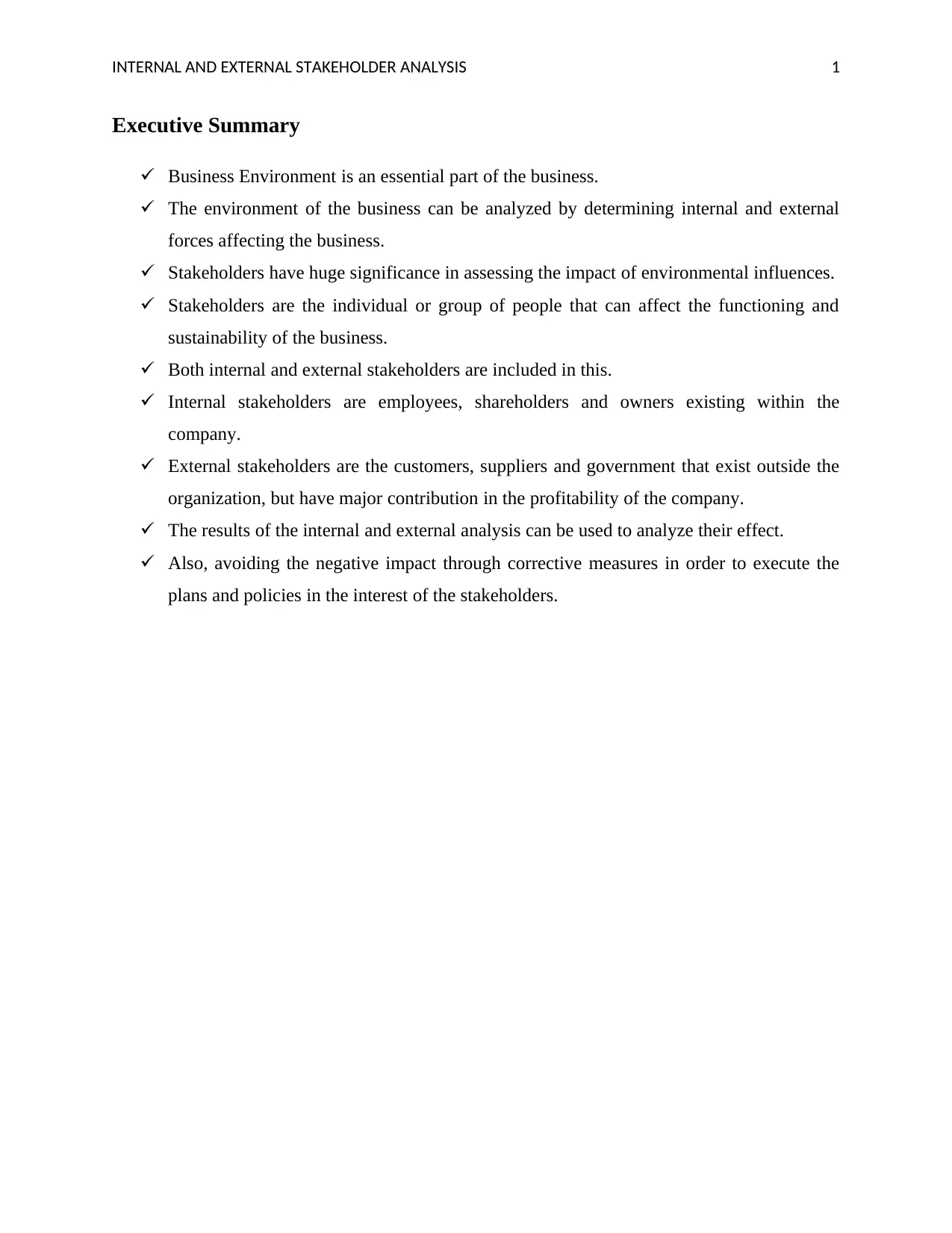
INTERNAL AND EXTERNAL STAKEHOLDER ANALYSIS 1
Executive Summary
Business Environment is an essential part of the business.
The environment of the business can be analyzed by determining internal and external
forces affecting the business.
Stakeholders have huge significance in assessing the impact of environmental influences.
Stakeholders are the individual or group of people that can affect the functioning and
sustainability of the business.
Both internal and external stakeholders are included in this.
Internal stakeholders are employees, shareholders and owners existing within the
company.
External stakeholders are the customers, suppliers and government that exist outside the
organization, but have major contribution in the profitability of the company.
The results of the internal and external analysis can be used to analyze their effect.
Also, avoiding the negative impact through corrective measures in order to execute the
plans and policies in the interest of the stakeholders.
Executive Summary
Business Environment is an essential part of the business.
The environment of the business can be analyzed by determining internal and external
forces affecting the business.
Stakeholders have huge significance in assessing the impact of environmental influences.
Stakeholders are the individual or group of people that can affect the functioning and
sustainability of the business.
Both internal and external stakeholders are included in this.
Internal stakeholders are employees, shareholders and owners existing within the
company.
External stakeholders are the customers, suppliers and government that exist outside the
organization, but have major contribution in the profitability of the company.
The results of the internal and external analysis can be used to analyze their effect.
Also, avoiding the negative impact through corrective measures in order to execute the
plans and policies in the interest of the stakeholders.
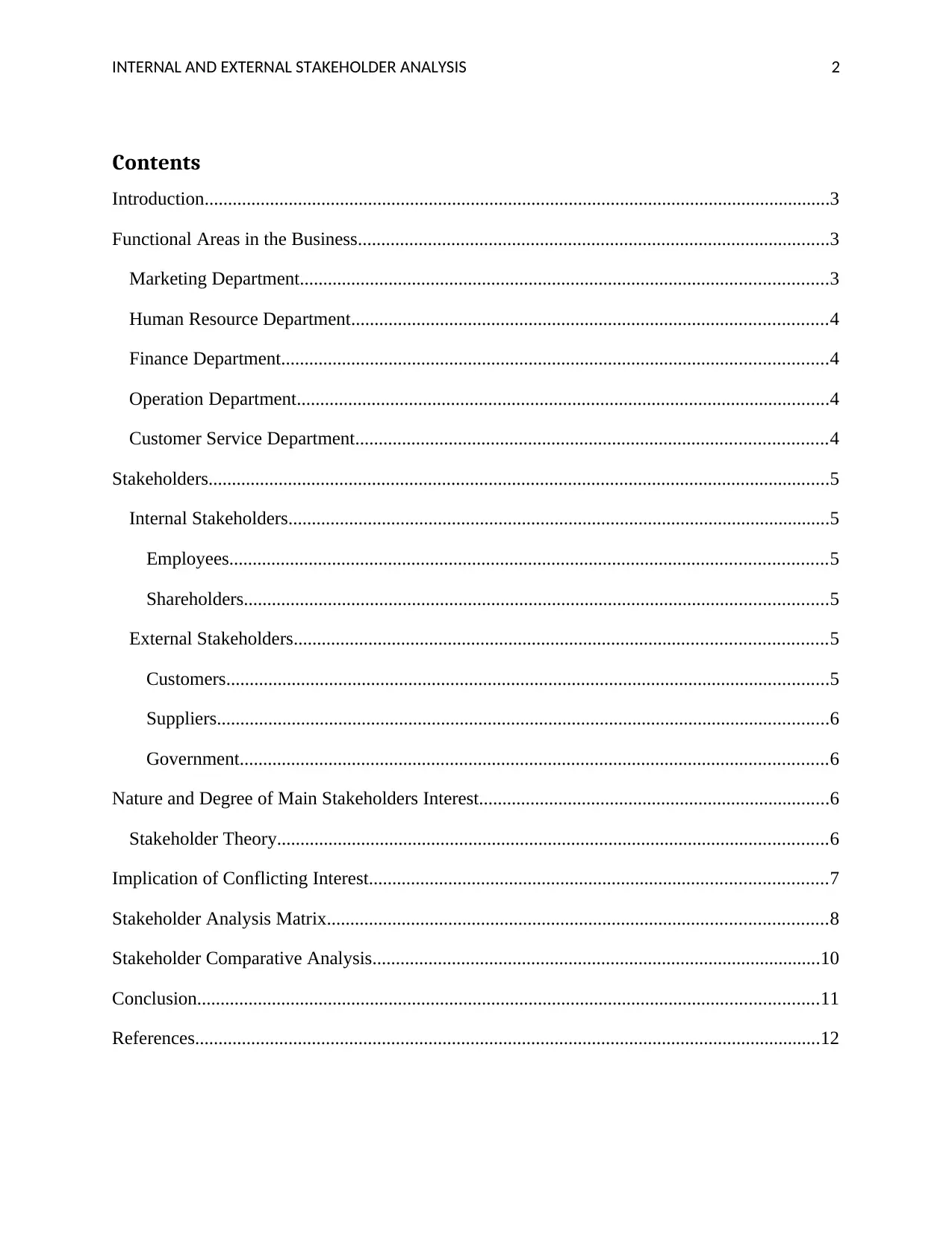
INTERNAL AND EXTERNAL STAKEHOLDER ANALYSIS 2
Contents
Introduction......................................................................................................................................3
Functional Areas in the Business.....................................................................................................3
Marketing Department.................................................................................................................3
Human Resource Department......................................................................................................4
Finance Department.....................................................................................................................4
Operation Department..................................................................................................................4
Customer Service Department.....................................................................................................4
Stakeholders.....................................................................................................................................5
Internal Stakeholders....................................................................................................................5
Employees................................................................................................................................5
Shareholders.............................................................................................................................5
External Stakeholders..................................................................................................................5
Customers.................................................................................................................................5
Suppliers...................................................................................................................................6
Government..............................................................................................................................6
Nature and Degree of Main Stakeholders Interest...........................................................................6
Stakeholder Theory......................................................................................................................6
Implication of Conflicting Interest..................................................................................................7
Stakeholder Analysis Matrix...........................................................................................................8
Stakeholder Comparative Analysis................................................................................................10
Conclusion.....................................................................................................................................11
References......................................................................................................................................12
Contents
Introduction......................................................................................................................................3
Functional Areas in the Business.....................................................................................................3
Marketing Department.................................................................................................................3
Human Resource Department......................................................................................................4
Finance Department.....................................................................................................................4
Operation Department..................................................................................................................4
Customer Service Department.....................................................................................................4
Stakeholders.....................................................................................................................................5
Internal Stakeholders....................................................................................................................5
Employees................................................................................................................................5
Shareholders.............................................................................................................................5
External Stakeholders..................................................................................................................5
Customers.................................................................................................................................5
Suppliers...................................................................................................................................6
Government..............................................................................................................................6
Nature and Degree of Main Stakeholders Interest...........................................................................6
Stakeholder Theory......................................................................................................................6
Implication of Conflicting Interest..................................................................................................7
Stakeholder Analysis Matrix...........................................................................................................8
Stakeholder Comparative Analysis................................................................................................10
Conclusion.....................................................................................................................................11
References......................................................................................................................................12
⊘ This is a preview!⊘
Do you want full access?
Subscribe today to unlock all pages.

Trusted by 1+ million students worldwide
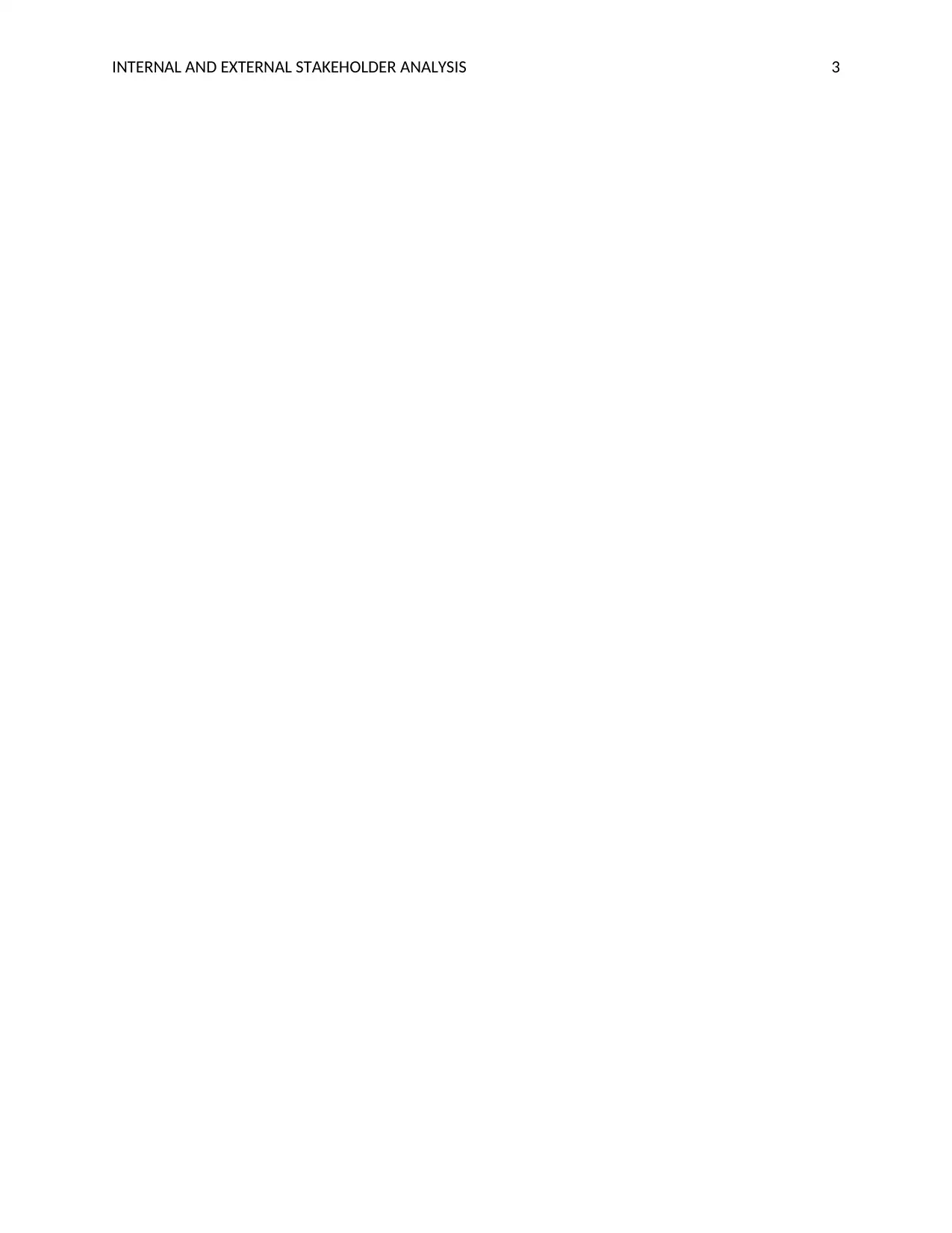
INTERNAL AND EXTERNAL STAKEHOLDER ANALYSIS 3
Paraphrase This Document
Need a fresh take? Get an instant paraphrase of this document with our AI Paraphraser
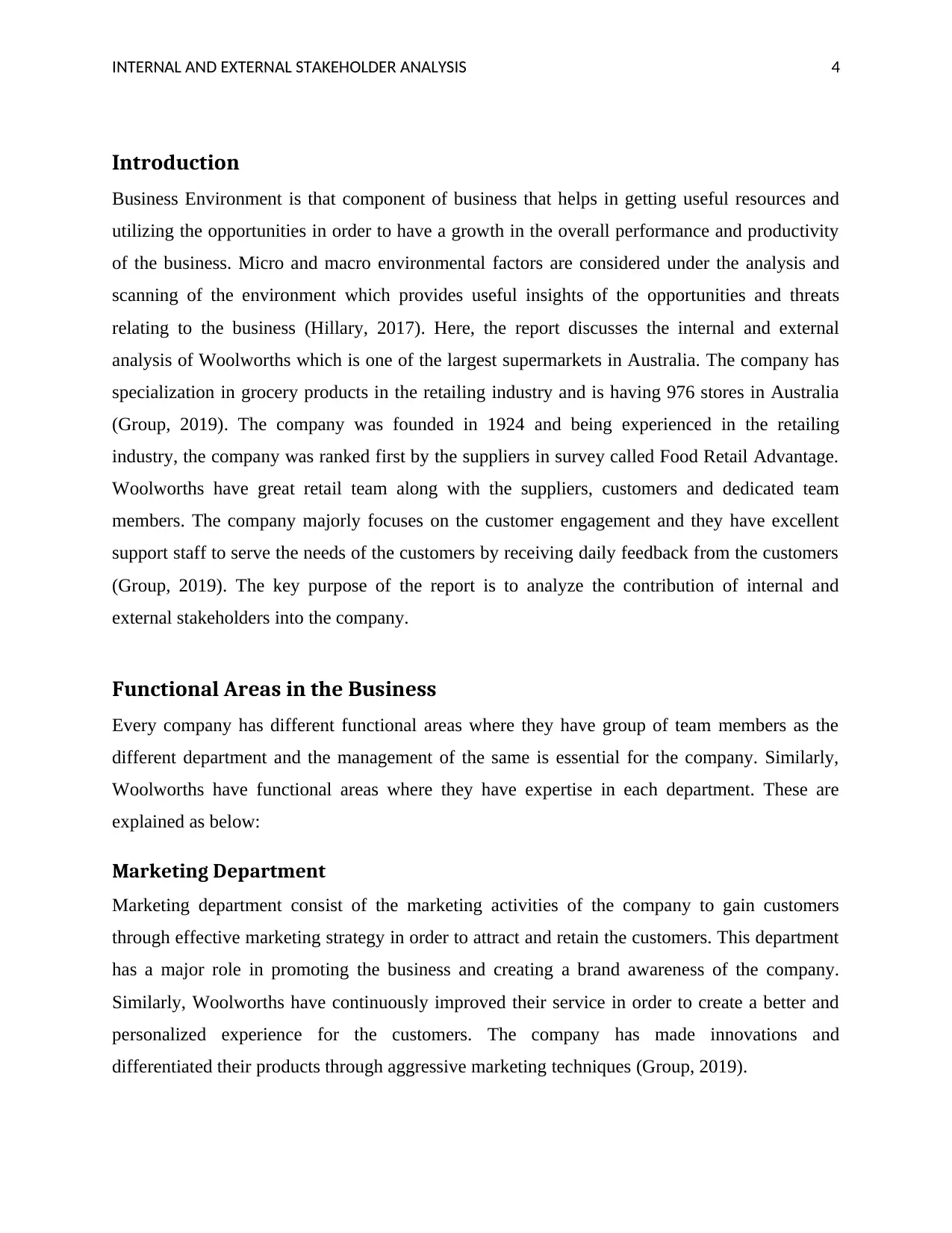
INTERNAL AND EXTERNAL STAKEHOLDER ANALYSIS 4
Introduction
Business Environment is that component of business that helps in getting useful resources and
utilizing the opportunities in order to have a growth in the overall performance and productivity
of the business. Micro and macro environmental factors are considered under the analysis and
scanning of the environment which provides useful insights of the opportunities and threats
relating to the business (Hillary, 2017). Here, the report discusses the internal and external
analysis of Woolworths which is one of the largest supermarkets in Australia. The company has
specialization in grocery products in the retailing industry and is having 976 stores in Australia
(Group, 2019). The company was founded in 1924 and being experienced in the retailing
industry, the company was ranked first by the suppliers in survey called Food Retail Advantage.
Woolworths have great retail team along with the suppliers, customers and dedicated team
members. The company majorly focuses on the customer engagement and they have excellent
support staff to serve the needs of the customers by receiving daily feedback from the customers
(Group, 2019). The key purpose of the report is to analyze the contribution of internal and
external stakeholders into the company.
Functional Areas in the Business
Every company has different functional areas where they have group of team members as the
different department and the management of the same is essential for the company. Similarly,
Woolworths have functional areas where they have expertise in each department. These are
explained as below:
Marketing Department
Marketing department consist of the marketing activities of the company to gain customers
through effective marketing strategy in order to attract and retain the customers. This department
has a major role in promoting the business and creating a brand awareness of the company.
Similarly, Woolworths have continuously improved their service in order to create a better and
personalized experience for the customers. The company has made innovations and
differentiated their products through aggressive marketing techniques (Group, 2019).
Introduction
Business Environment is that component of business that helps in getting useful resources and
utilizing the opportunities in order to have a growth in the overall performance and productivity
of the business. Micro and macro environmental factors are considered under the analysis and
scanning of the environment which provides useful insights of the opportunities and threats
relating to the business (Hillary, 2017). Here, the report discusses the internal and external
analysis of Woolworths which is one of the largest supermarkets in Australia. The company has
specialization in grocery products in the retailing industry and is having 976 stores in Australia
(Group, 2019). The company was founded in 1924 and being experienced in the retailing
industry, the company was ranked first by the suppliers in survey called Food Retail Advantage.
Woolworths have great retail team along with the suppliers, customers and dedicated team
members. The company majorly focuses on the customer engagement and they have excellent
support staff to serve the needs of the customers by receiving daily feedback from the customers
(Group, 2019). The key purpose of the report is to analyze the contribution of internal and
external stakeholders into the company.
Functional Areas in the Business
Every company has different functional areas where they have group of team members as the
different department and the management of the same is essential for the company. Similarly,
Woolworths have functional areas where they have expertise in each department. These are
explained as below:
Marketing Department
Marketing department consist of the marketing activities of the company to gain customers
through effective marketing strategy in order to attract and retain the customers. This department
has a major role in promoting the business and creating a brand awareness of the company.
Similarly, Woolworths have continuously improved their service in order to create a better and
personalized experience for the customers. The company has made innovations and
differentiated their products through aggressive marketing techniques (Group, 2019).
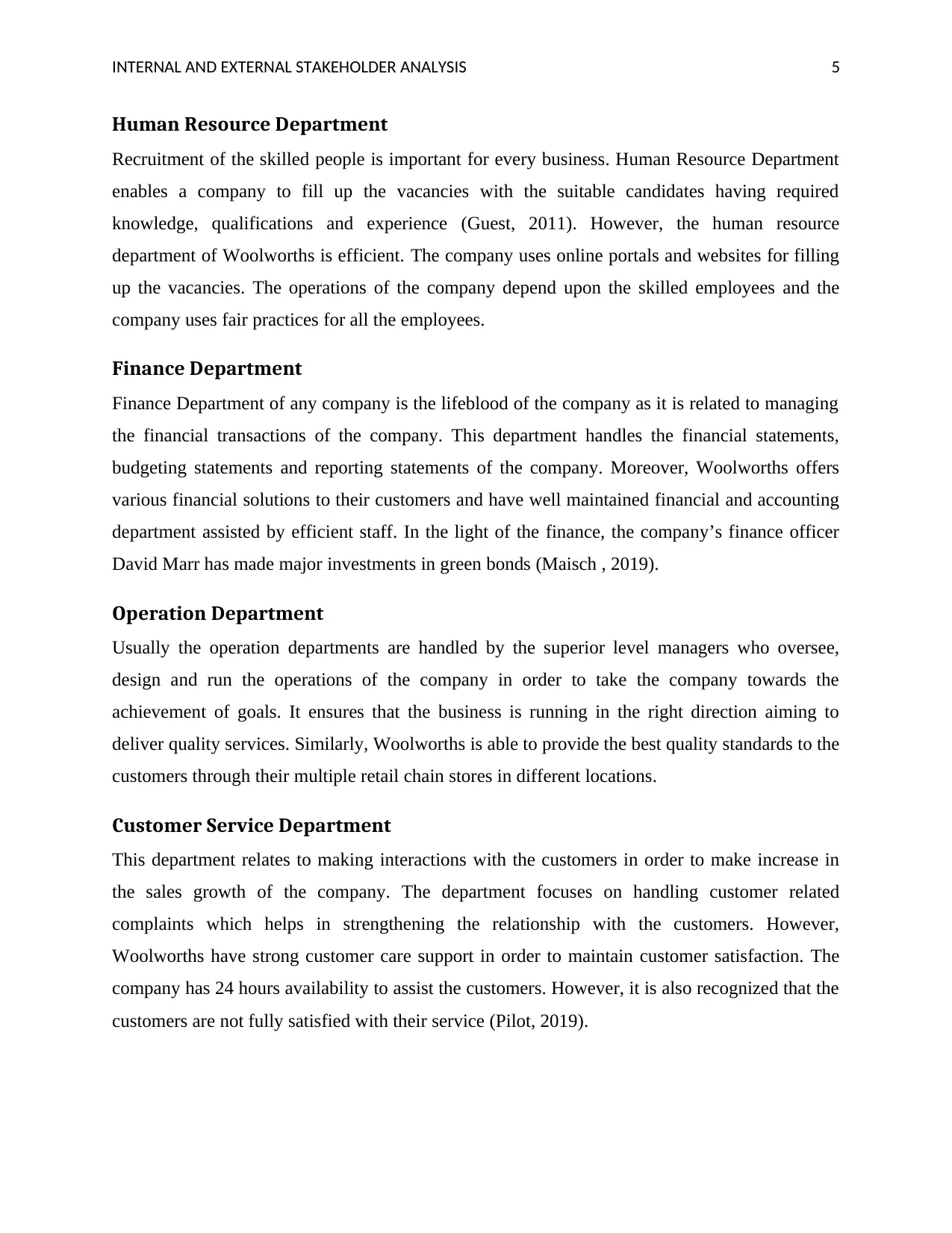
INTERNAL AND EXTERNAL STAKEHOLDER ANALYSIS 5
Human Resource Department
Recruitment of the skilled people is important for every business. Human Resource Department
enables a company to fill up the vacancies with the suitable candidates having required
knowledge, qualifications and experience (Guest, 2011). However, the human resource
department of Woolworths is efficient. The company uses online portals and websites for filling
up the vacancies. The operations of the company depend upon the skilled employees and the
company uses fair practices for all the employees.
Finance Department
Finance Department of any company is the lifeblood of the company as it is related to managing
the financial transactions of the company. This department handles the financial statements,
budgeting statements and reporting statements of the company. Moreover, Woolworths offers
various financial solutions to their customers and have well maintained financial and accounting
department assisted by efficient staff. In the light of the finance, the company’s finance officer
David Marr has made major investments in green bonds (Maisch , 2019).
Operation Department
Usually the operation departments are handled by the superior level managers who oversee,
design and run the operations of the company in order to take the company towards the
achievement of goals. It ensures that the business is running in the right direction aiming to
deliver quality services. Similarly, Woolworths is able to provide the best quality standards to the
customers through their multiple retail chain stores in different locations.
Customer Service Department
This department relates to making interactions with the customers in order to make increase in
the sales growth of the company. The department focuses on handling customer related
complaints which helps in strengthening the relationship with the customers. However,
Woolworths have strong customer care support in order to maintain customer satisfaction. The
company has 24 hours availability to assist the customers. However, it is also recognized that the
customers are not fully satisfied with their service (Pilot, 2019).
Human Resource Department
Recruitment of the skilled people is important for every business. Human Resource Department
enables a company to fill up the vacancies with the suitable candidates having required
knowledge, qualifications and experience (Guest, 2011). However, the human resource
department of Woolworths is efficient. The company uses online portals and websites for filling
up the vacancies. The operations of the company depend upon the skilled employees and the
company uses fair practices for all the employees.
Finance Department
Finance Department of any company is the lifeblood of the company as it is related to managing
the financial transactions of the company. This department handles the financial statements,
budgeting statements and reporting statements of the company. Moreover, Woolworths offers
various financial solutions to their customers and have well maintained financial and accounting
department assisted by efficient staff. In the light of the finance, the company’s finance officer
David Marr has made major investments in green bonds (Maisch , 2019).
Operation Department
Usually the operation departments are handled by the superior level managers who oversee,
design and run the operations of the company in order to take the company towards the
achievement of goals. It ensures that the business is running in the right direction aiming to
deliver quality services. Similarly, Woolworths is able to provide the best quality standards to the
customers through their multiple retail chain stores in different locations.
Customer Service Department
This department relates to making interactions with the customers in order to make increase in
the sales growth of the company. The department focuses on handling customer related
complaints which helps in strengthening the relationship with the customers. However,
Woolworths have strong customer care support in order to maintain customer satisfaction. The
company has 24 hours availability to assist the customers. However, it is also recognized that the
customers are not fully satisfied with their service (Pilot, 2019).
⊘ This is a preview!⊘
Do you want full access?
Subscribe today to unlock all pages.

Trusted by 1+ million students worldwide
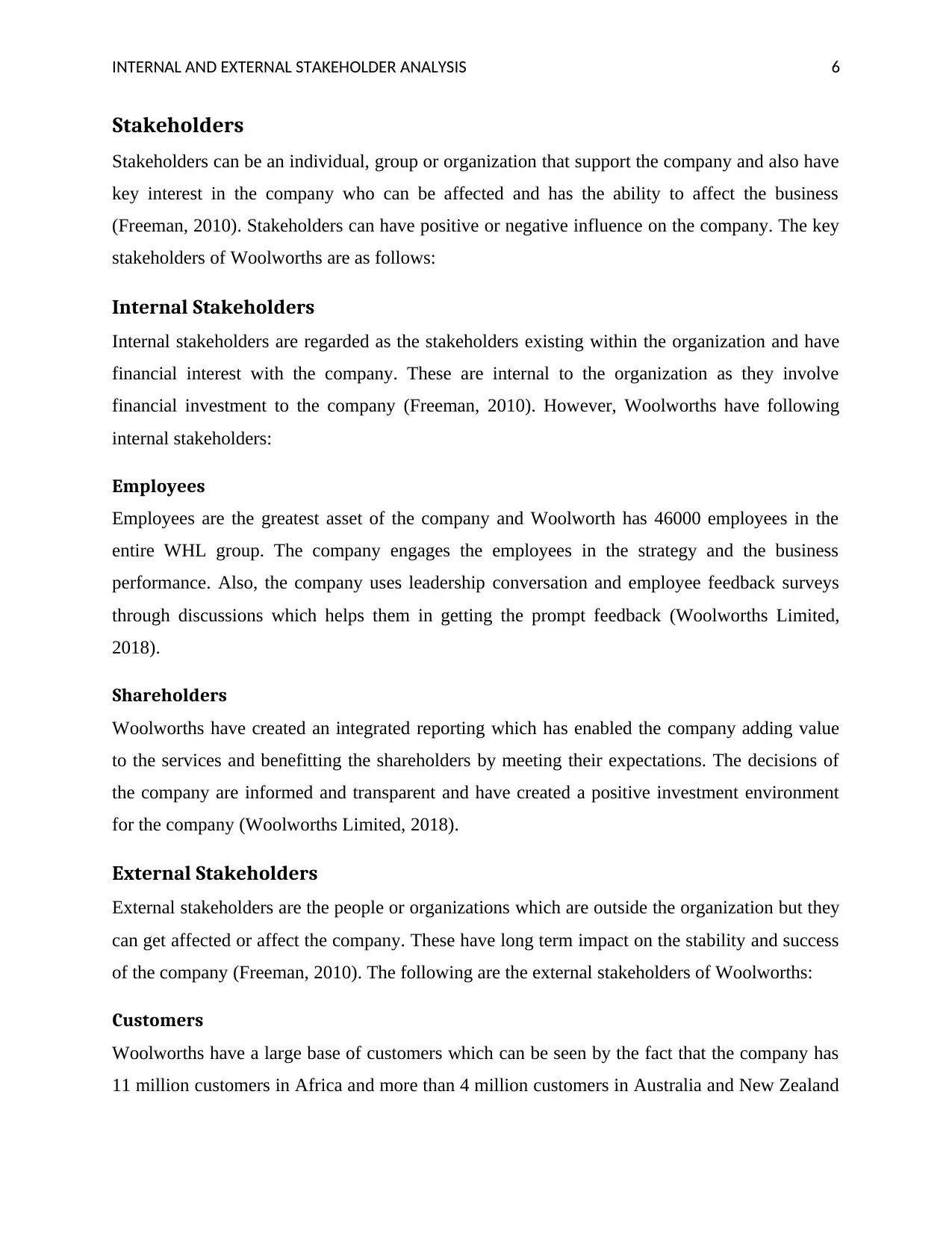
INTERNAL AND EXTERNAL STAKEHOLDER ANALYSIS 6
Stakeholders
Stakeholders can be an individual, group or organization that support the company and also have
key interest in the company who can be affected and has the ability to affect the business
(Freeman, 2010). Stakeholders can have positive or negative influence on the company. The key
stakeholders of Woolworths are as follows:
Internal Stakeholders
Internal stakeholders are regarded as the stakeholders existing within the organization and have
financial interest with the company. These are internal to the organization as they involve
financial investment to the company (Freeman, 2010). However, Woolworths have following
internal stakeholders:
Employees
Employees are the greatest asset of the company and Woolworth has 46000 employees in the
entire WHL group. The company engages the employees in the strategy and the business
performance. Also, the company uses leadership conversation and employee feedback surveys
through discussions which helps them in getting the prompt feedback (Woolworths Limited,
2018).
Shareholders
Woolworths have created an integrated reporting which has enabled the company adding value
to the services and benefitting the shareholders by meeting their expectations. The decisions of
the company are informed and transparent and have created a positive investment environment
for the company (Woolworths Limited, 2018).
External Stakeholders
External stakeholders are the people or organizations which are outside the organization but they
can get affected or affect the company. These have long term impact on the stability and success
of the company (Freeman, 2010). The following are the external stakeholders of Woolworths:
Customers
Woolworths have a large base of customers which can be seen by the fact that the company has
11 million customers in Africa and more than 4 million customers in Australia and New Zealand
Stakeholders
Stakeholders can be an individual, group or organization that support the company and also have
key interest in the company who can be affected and has the ability to affect the business
(Freeman, 2010). Stakeholders can have positive or negative influence on the company. The key
stakeholders of Woolworths are as follows:
Internal Stakeholders
Internal stakeholders are regarded as the stakeholders existing within the organization and have
financial interest with the company. These are internal to the organization as they involve
financial investment to the company (Freeman, 2010). However, Woolworths have following
internal stakeholders:
Employees
Employees are the greatest asset of the company and Woolworth has 46000 employees in the
entire WHL group. The company engages the employees in the strategy and the business
performance. Also, the company uses leadership conversation and employee feedback surveys
through discussions which helps them in getting the prompt feedback (Woolworths Limited,
2018).
Shareholders
Woolworths have created an integrated reporting which has enabled the company adding value
to the services and benefitting the shareholders by meeting their expectations. The decisions of
the company are informed and transparent and have created a positive investment environment
for the company (Woolworths Limited, 2018).
External Stakeholders
External stakeholders are the people or organizations which are outside the organization but they
can get affected or affect the company. These have long term impact on the stability and success
of the company (Freeman, 2010). The following are the external stakeholders of Woolworths:
Customers
Woolworths have a large base of customers which can be seen by the fact that the company has
11 million customers in Africa and more than 4 million customers in Australia and New Zealand
Paraphrase This Document
Need a fresh take? Get an instant paraphrase of this document with our AI Paraphraser
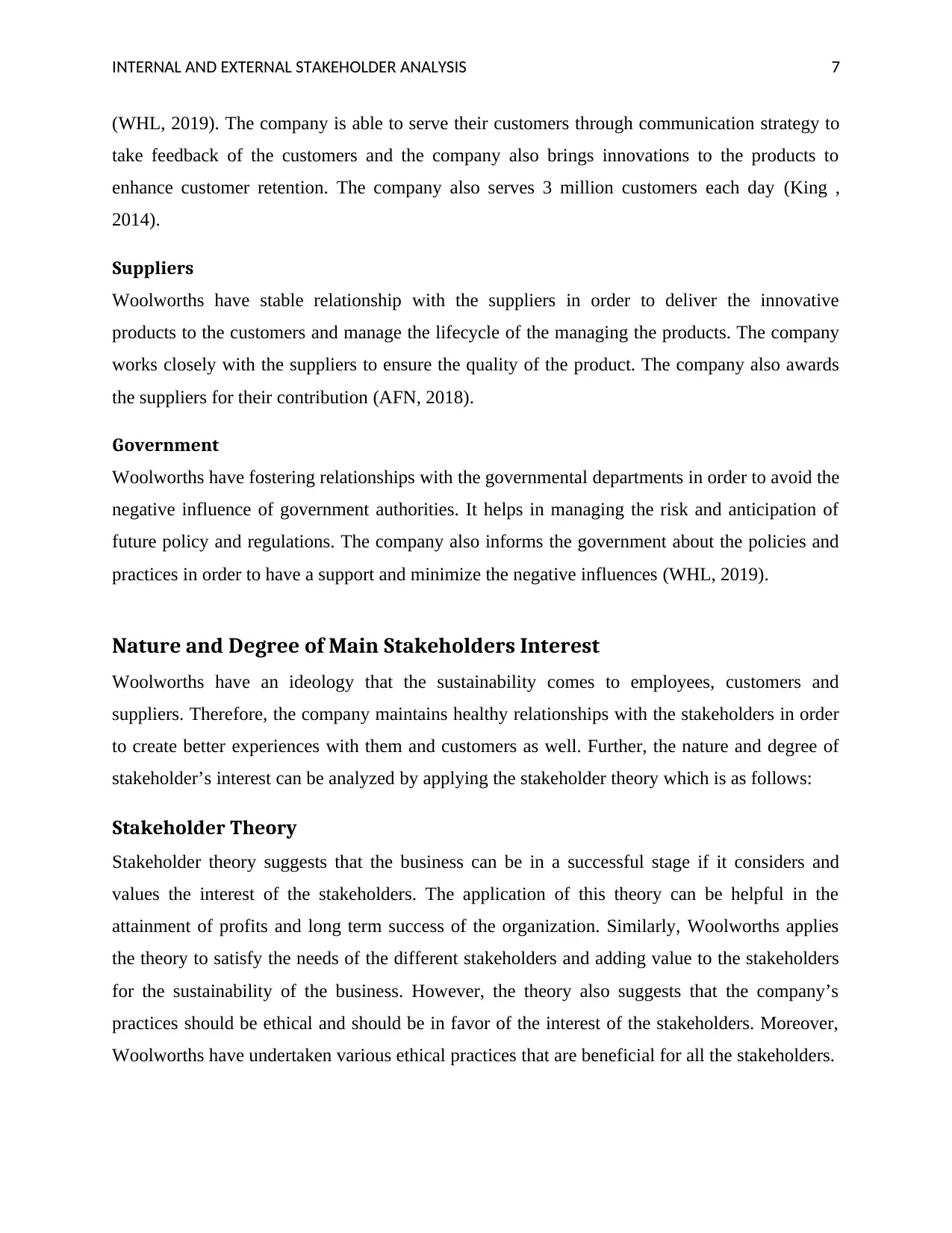
INTERNAL AND EXTERNAL STAKEHOLDER ANALYSIS 7
(WHL, 2019). The company is able to serve their customers through communication strategy to
take feedback of the customers and the company also brings innovations to the products to
enhance customer retention. The company also serves 3 million customers each day (King ,
2014).
Suppliers
Woolworths have stable relationship with the suppliers in order to deliver the innovative
products to the customers and manage the lifecycle of the managing the products. The company
works closely with the suppliers to ensure the quality of the product. The company also awards
the suppliers for their contribution (AFN, 2018).
Government
Woolworths have fostering relationships with the governmental departments in order to avoid the
negative influence of government authorities. It helps in managing the risk and anticipation of
future policy and regulations. The company also informs the government about the policies and
practices in order to have a support and minimize the negative influences (WHL, 2019).
Nature and Degree of Main Stakeholders Interest
Woolworths have an ideology that the sustainability comes to employees, customers and
suppliers. Therefore, the company maintains healthy relationships with the stakeholders in order
to create better experiences with them and customers as well. Further, the nature and degree of
stakeholder’s interest can be analyzed by applying the stakeholder theory which is as follows:
Stakeholder Theory
Stakeholder theory suggests that the business can be in a successful stage if it considers and
values the interest of the stakeholders. The application of this theory can be helpful in the
attainment of profits and long term success of the organization. Similarly, Woolworths applies
the theory to satisfy the needs of the different stakeholders and adding value to the stakeholders
for the sustainability of the business. However, the theory also suggests that the company’s
practices should be ethical and should be in favor of the interest of the stakeholders. Moreover,
Woolworths have undertaken various ethical practices that are beneficial for all the stakeholders.
(WHL, 2019). The company is able to serve their customers through communication strategy to
take feedback of the customers and the company also brings innovations to the products to
enhance customer retention. The company also serves 3 million customers each day (King ,
2014).
Suppliers
Woolworths have stable relationship with the suppliers in order to deliver the innovative
products to the customers and manage the lifecycle of the managing the products. The company
works closely with the suppliers to ensure the quality of the product. The company also awards
the suppliers for their contribution (AFN, 2018).
Government
Woolworths have fostering relationships with the governmental departments in order to avoid the
negative influence of government authorities. It helps in managing the risk and anticipation of
future policy and regulations. The company also informs the government about the policies and
practices in order to have a support and minimize the negative influences (WHL, 2019).
Nature and Degree of Main Stakeholders Interest
Woolworths have an ideology that the sustainability comes to employees, customers and
suppliers. Therefore, the company maintains healthy relationships with the stakeholders in order
to create better experiences with them and customers as well. Further, the nature and degree of
stakeholder’s interest can be analyzed by applying the stakeholder theory which is as follows:
Stakeholder Theory
Stakeholder theory suggests that the business can be in a successful stage if it considers and
values the interest of the stakeholders. The application of this theory can be helpful in the
attainment of profits and long term success of the organization. Similarly, Woolworths applies
the theory to satisfy the needs of the different stakeholders and adding value to the stakeholders
for the sustainability of the business. However, the theory also suggests that the company’s
practices should be ethical and should be in favor of the interest of the stakeholders. Moreover,
Woolworths have undertaken various ethical practices that are beneficial for all the stakeholders.
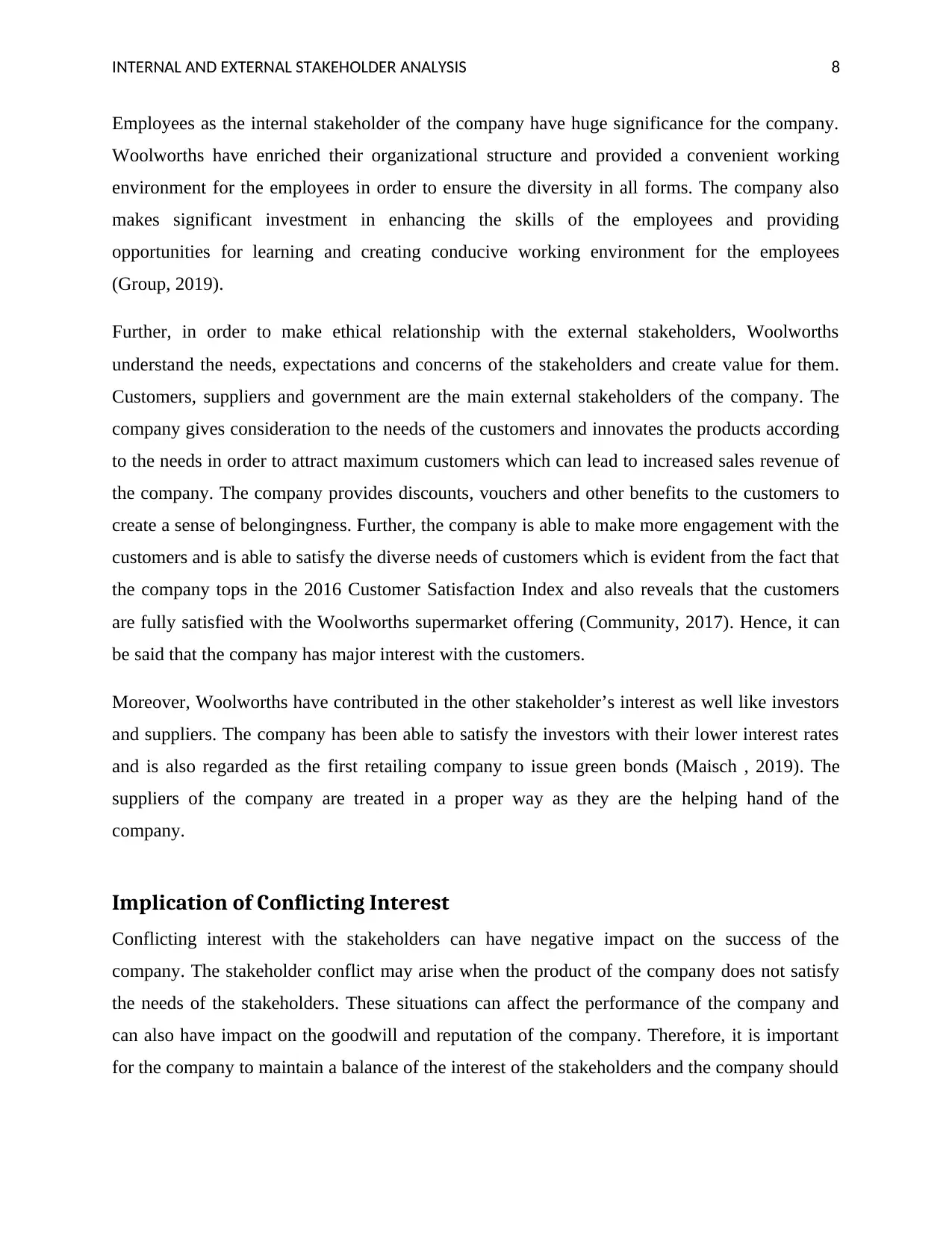
INTERNAL AND EXTERNAL STAKEHOLDER ANALYSIS 8
Employees as the internal stakeholder of the company have huge significance for the company.
Woolworths have enriched their organizational structure and provided a convenient working
environment for the employees in order to ensure the diversity in all forms. The company also
makes significant investment in enhancing the skills of the employees and providing
opportunities for learning and creating conducive working environment for the employees
(Group, 2019).
Further, in order to make ethical relationship with the external stakeholders, Woolworths
understand the needs, expectations and concerns of the stakeholders and create value for them.
Customers, suppliers and government are the main external stakeholders of the company. The
company gives consideration to the needs of the customers and innovates the products according
to the needs in order to attract maximum customers which can lead to increased sales revenue of
the company. The company provides discounts, vouchers and other benefits to the customers to
create a sense of belongingness. Further, the company is able to make more engagement with the
customers and is able to satisfy the diverse needs of customers which is evident from the fact that
the company tops in the 2016 Customer Satisfaction Index and also reveals that the customers
are fully satisfied with the Woolworths supermarket offering (Community, 2017). Hence, it can
be said that the company has major interest with the customers.
Moreover, Woolworths have contributed in the other stakeholder’s interest as well like investors
and suppliers. The company has been able to satisfy the investors with their lower interest rates
and is also regarded as the first retailing company to issue green bonds (Maisch , 2019). The
suppliers of the company are treated in a proper way as they are the helping hand of the
company.
Implication of Conflicting Interest
Conflicting interest with the stakeholders can have negative impact on the success of the
company. The stakeholder conflict may arise when the product of the company does not satisfy
the needs of the stakeholders. These situations can affect the performance of the company and
can also have impact on the goodwill and reputation of the company. Therefore, it is important
for the company to maintain a balance of the interest of the stakeholders and the company should
Employees as the internal stakeholder of the company have huge significance for the company.
Woolworths have enriched their organizational structure and provided a convenient working
environment for the employees in order to ensure the diversity in all forms. The company also
makes significant investment in enhancing the skills of the employees and providing
opportunities for learning and creating conducive working environment for the employees
(Group, 2019).
Further, in order to make ethical relationship with the external stakeholders, Woolworths
understand the needs, expectations and concerns of the stakeholders and create value for them.
Customers, suppliers and government are the main external stakeholders of the company. The
company gives consideration to the needs of the customers and innovates the products according
to the needs in order to attract maximum customers which can lead to increased sales revenue of
the company. The company provides discounts, vouchers and other benefits to the customers to
create a sense of belongingness. Further, the company is able to make more engagement with the
customers and is able to satisfy the diverse needs of customers which is evident from the fact that
the company tops in the 2016 Customer Satisfaction Index and also reveals that the customers
are fully satisfied with the Woolworths supermarket offering (Community, 2017). Hence, it can
be said that the company has major interest with the customers.
Moreover, Woolworths have contributed in the other stakeholder’s interest as well like investors
and suppliers. The company has been able to satisfy the investors with their lower interest rates
and is also regarded as the first retailing company to issue green bonds (Maisch , 2019). The
suppliers of the company are treated in a proper way as they are the helping hand of the
company.
Implication of Conflicting Interest
Conflicting interest with the stakeholders can have negative impact on the success of the
company. The stakeholder conflict may arise when the product of the company does not satisfy
the needs of the stakeholders. These situations can affect the performance of the company and
can also have impact on the goodwill and reputation of the company. Therefore, it is important
for the company to maintain a balance of the interest of the stakeholders and the company should
⊘ This is a preview!⊘
Do you want full access?
Subscribe today to unlock all pages.

Trusted by 1+ million students worldwide
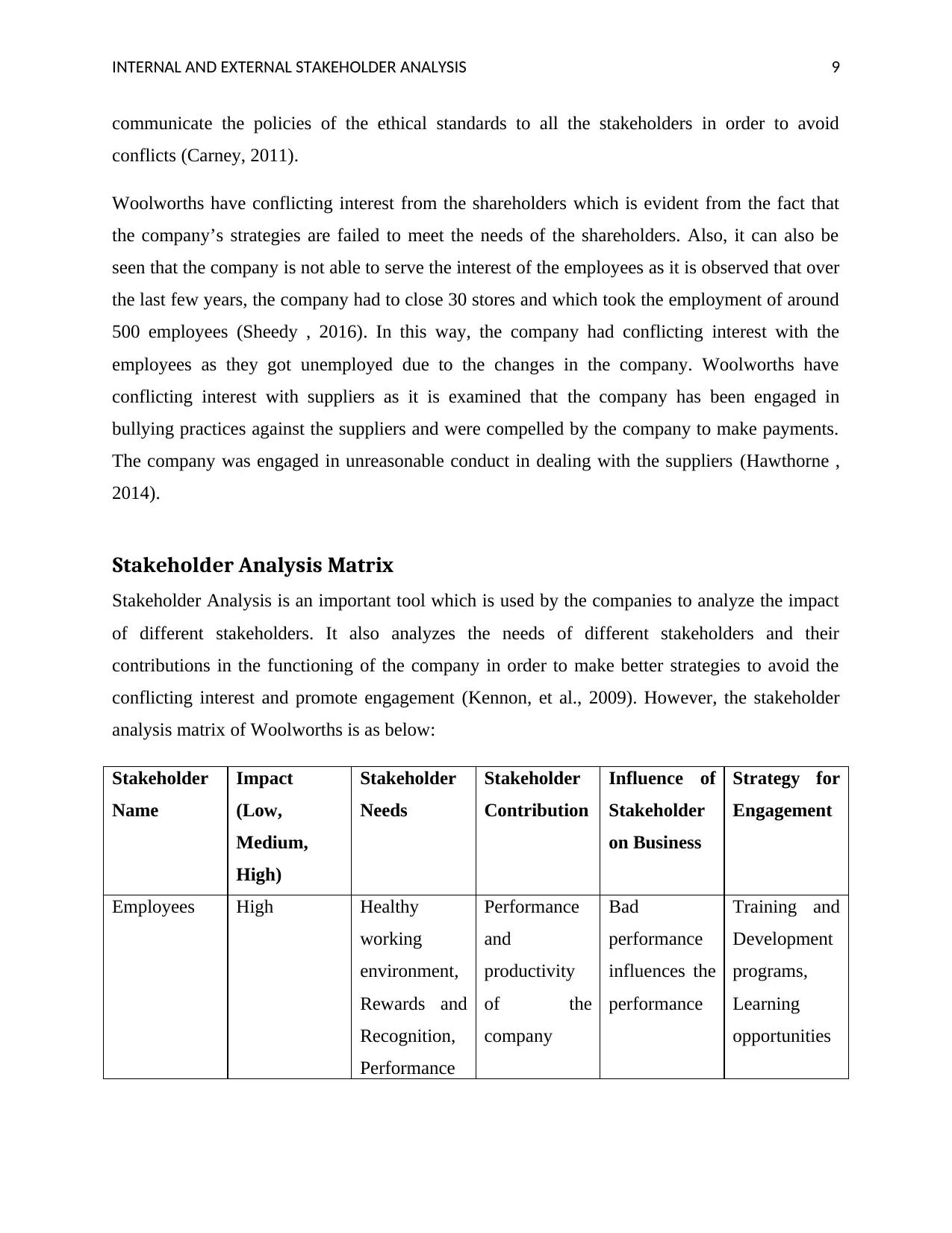
INTERNAL AND EXTERNAL STAKEHOLDER ANALYSIS 9
communicate the policies of the ethical standards to all the stakeholders in order to avoid
conflicts (Carney, 2011).
Woolworths have conflicting interest from the shareholders which is evident from the fact that
the company’s strategies are failed to meet the needs of the shareholders. Also, it can also be
seen that the company is not able to serve the interest of the employees as it is observed that over
the last few years, the company had to close 30 stores and which took the employment of around
500 employees (Sheedy , 2016). In this way, the company had conflicting interest with the
employees as they got unemployed due to the changes in the company. Woolworths have
conflicting interest with suppliers as it is examined that the company has been engaged in
bullying practices against the suppliers and were compelled by the company to make payments.
The company was engaged in unreasonable conduct in dealing with the suppliers (Hawthorne ,
2014).
Stakeholder Analysis Matrix
Stakeholder Analysis is an important tool which is used by the companies to analyze the impact
of different stakeholders. It also analyzes the needs of different stakeholders and their
contributions in the functioning of the company in order to make better strategies to avoid the
conflicting interest and promote engagement (Kennon, et al., 2009). However, the stakeholder
analysis matrix of Woolworths is as below:
Stakeholder
Name
Impact
(Low,
Medium,
High)
Stakeholder
Needs
Stakeholder
Contribution
Influence of
Stakeholder
on Business
Strategy for
Engagement
Employees High Healthy
working
environment,
Rewards and
Recognition,
Performance
Performance
and
productivity
of the
company
Bad
performance
influences the
performance
Training and
Development
programs,
Learning
opportunities
communicate the policies of the ethical standards to all the stakeholders in order to avoid
conflicts (Carney, 2011).
Woolworths have conflicting interest from the shareholders which is evident from the fact that
the company’s strategies are failed to meet the needs of the shareholders. Also, it can also be
seen that the company is not able to serve the interest of the employees as it is observed that over
the last few years, the company had to close 30 stores and which took the employment of around
500 employees (Sheedy , 2016). In this way, the company had conflicting interest with the
employees as they got unemployed due to the changes in the company. Woolworths have
conflicting interest with suppliers as it is examined that the company has been engaged in
bullying practices against the suppliers and were compelled by the company to make payments.
The company was engaged in unreasonable conduct in dealing with the suppliers (Hawthorne ,
2014).
Stakeholder Analysis Matrix
Stakeholder Analysis is an important tool which is used by the companies to analyze the impact
of different stakeholders. It also analyzes the needs of different stakeholders and their
contributions in the functioning of the company in order to make better strategies to avoid the
conflicting interest and promote engagement (Kennon, et al., 2009). However, the stakeholder
analysis matrix of Woolworths is as below:
Stakeholder
Name
Impact
(Low,
Medium,
High)
Stakeholder
Needs
Stakeholder
Contribution
Influence of
Stakeholder
on Business
Strategy for
Engagement
Employees High Healthy
working
environment,
Rewards and
Recognition,
Performance
Performance
and
productivity
of the
company
Bad
performance
influences the
performance
Training and
Development
programs,
Learning
opportunities
Paraphrase This Document
Need a fresh take? Get an instant paraphrase of this document with our AI Paraphraser
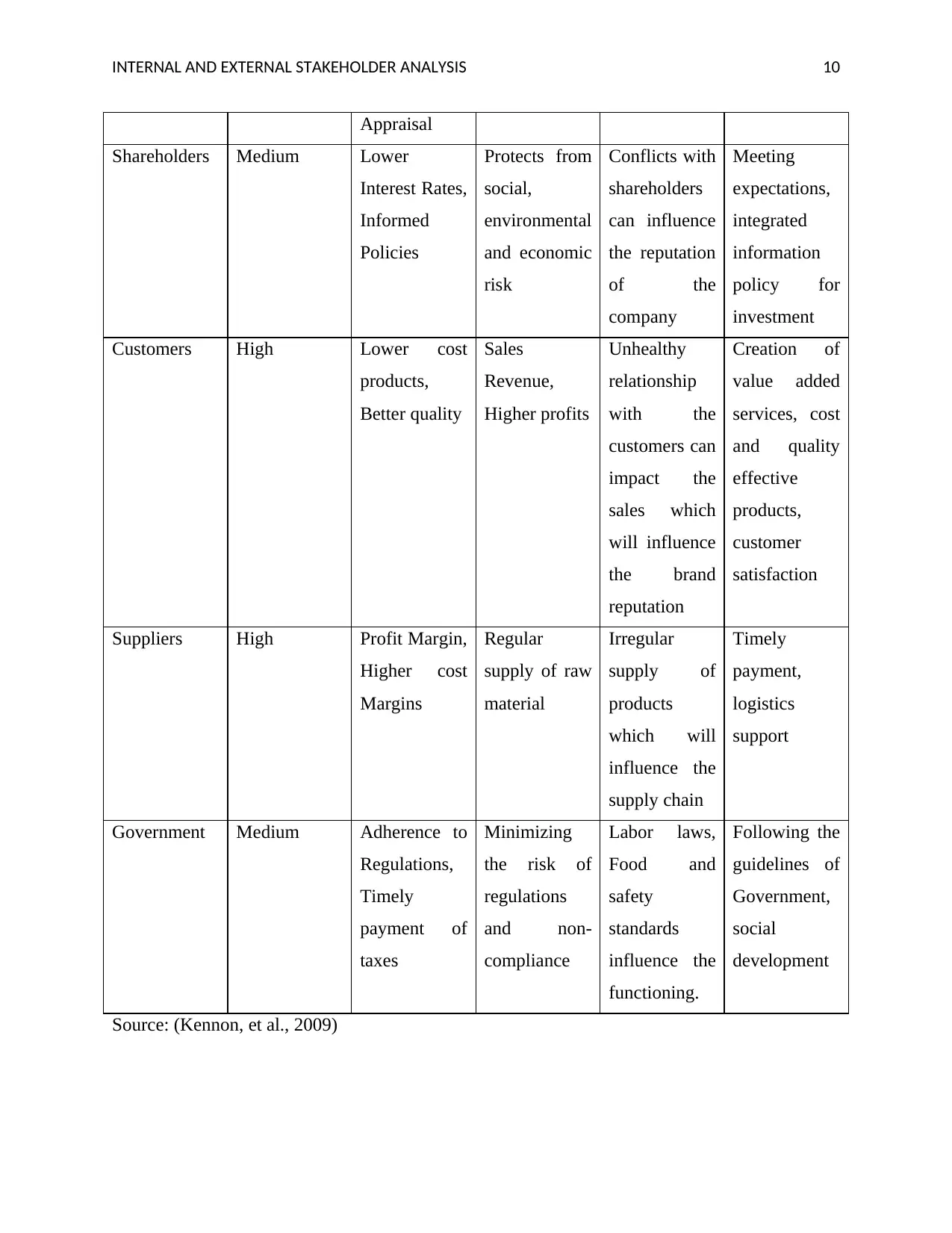
INTERNAL AND EXTERNAL STAKEHOLDER ANALYSIS 10
Appraisal
Shareholders Medium Lower
Interest Rates,
Informed
Policies
Protects from
social,
environmental
and economic
risk
Conflicts with
shareholders
can influence
the reputation
of the
company
Meeting
expectations,
integrated
information
policy for
investment
Customers High Lower cost
products,
Better quality
Sales
Revenue,
Higher profits
Unhealthy
relationship
with the
customers can
impact the
sales which
will influence
the brand
reputation
Creation of
value added
services, cost
and quality
effective
products,
customer
satisfaction
Suppliers High Profit Margin,
Higher cost
Margins
Regular
supply of raw
material
Irregular
supply of
products
which will
influence the
supply chain
Timely
payment,
logistics
support
Government Medium Adherence to
Regulations,
Timely
payment of
taxes
Minimizing
the risk of
regulations
and non-
compliance
Labor laws,
Food and
safety
standards
influence the
functioning.
Following the
guidelines of
Government,
social
development
Source: (Kennon, et al., 2009)
Appraisal
Shareholders Medium Lower
Interest Rates,
Informed
Policies
Protects from
social,
environmental
and economic
risk
Conflicts with
shareholders
can influence
the reputation
of the
company
Meeting
expectations,
integrated
information
policy for
investment
Customers High Lower cost
products,
Better quality
Sales
Revenue,
Higher profits
Unhealthy
relationship
with the
customers can
impact the
sales which
will influence
the brand
reputation
Creation of
value added
services, cost
and quality
effective
products,
customer
satisfaction
Suppliers High Profit Margin,
Higher cost
Margins
Regular
supply of raw
material
Irregular
supply of
products
which will
influence the
supply chain
Timely
payment,
logistics
support
Government Medium Adherence to
Regulations,
Timely
payment of
taxes
Minimizing
the risk of
regulations
and non-
compliance
Labor laws,
Food and
safety
standards
influence the
functioning.
Following the
guidelines of
Government,
social
development
Source: (Kennon, et al., 2009)
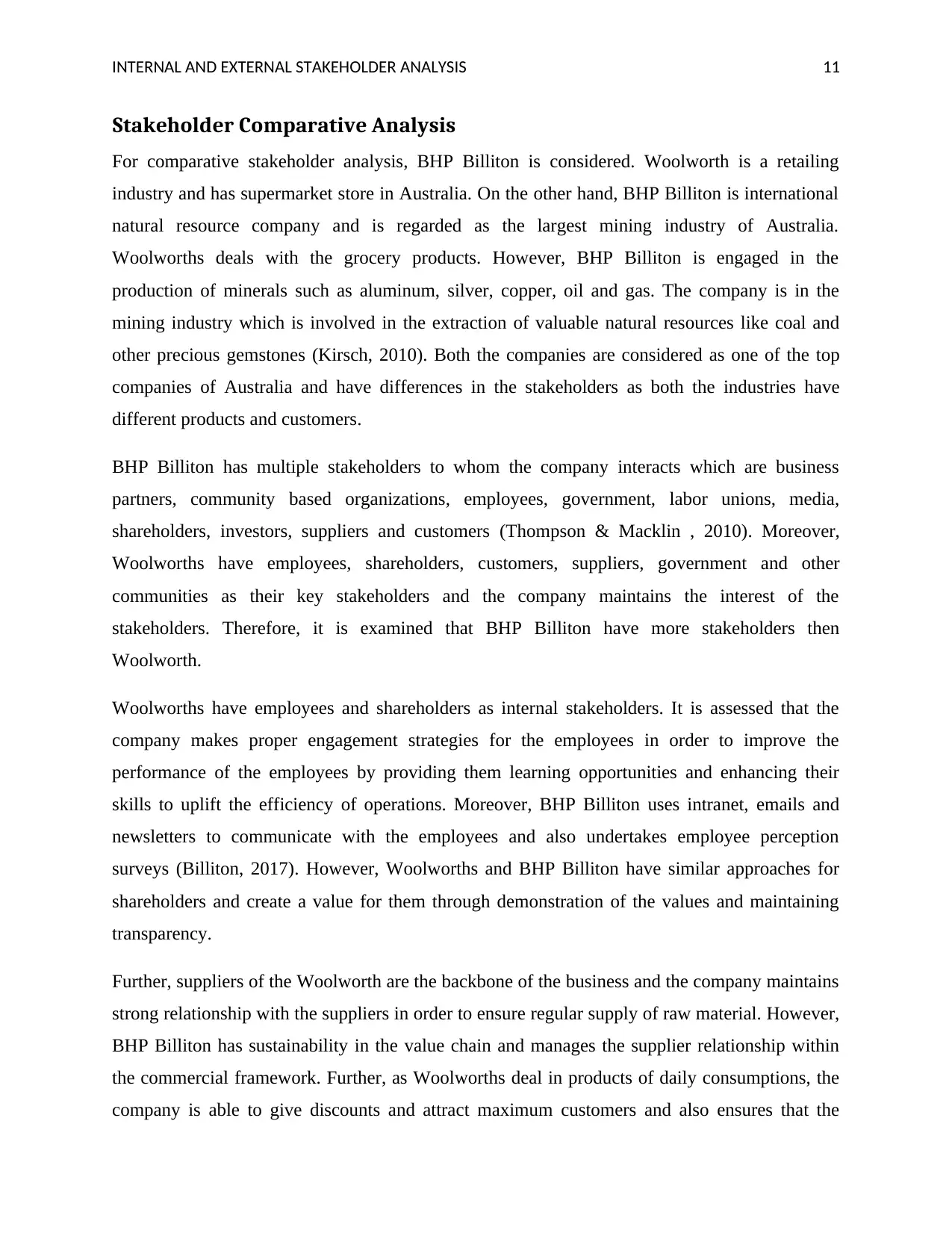
INTERNAL AND EXTERNAL STAKEHOLDER ANALYSIS 11
Stakeholder Comparative Analysis
For comparative stakeholder analysis, BHP Billiton is considered. Woolworth is a retailing
industry and has supermarket store in Australia. On the other hand, BHP Billiton is international
natural resource company and is regarded as the largest mining industry of Australia.
Woolworths deals with the grocery products. However, BHP Billiton is engaged in the
production of minerals such as aluminum, silver, copper, oil and gas. The company is in the
mining industry which is involved in the extraction of valuable natural resources like coal and
other precious gemstones (Kirsch, 2010). Both the companies are considered as one of the top
companies of Australia and have differences in the stakeholders as both the industries have
different products and customers.
BHP Billiton has multiple stakeholders to whom the company interacts which are business
partners, community based organizations, employees, government, labor unions, media,
shareholders, investors, suppliers and customers (Thompson & Macklin , 2010). Moreover,
Woolworths have employees, shareholders, customers, suppliers, government and other
communities as their key stakeholders and the company maintains the interest of the
stakeholders. Therefore, it is examined that BHP Billiton have more stakeholders then
Woolworth.
Woolworths have employees and shareholders as internal stakeholders. It is assessed that the
company makes proper engagement strategies for the employees in order to improve the
performance of the employees by providing them learning opportunities and enhancing their
skills to uplift the efficiency of operations. Moreover, BHP Billiton uses intranet, emails and
newsletters to communicate with the employees and also undertakes employee perception
surveys (Billiton, 2017). However, Woolworths and BHP Billiton have similar approaches for
shareholders and create a value for them through demonstration of the values and maintaining
transparency.
Further, suppliers of the Woolworth are the backbone of the business and the company maintains
strong relationship with the suppliers in order to ensure regular supply of raw material. However,
BHP Billiton has sustainability in the value chain and manages the supplier relationship within
the commercial framework. Further, as Woolworths deal in products of daily consumptions, the
company is able to give discounts and attract maximum customers and also ensures that the
Stakeholder Comparative Analysis
For comparative stakeholder analysis, BHP Billiton is considered. Woolworth is a retailing
industry and has supermarket store in Australia. On the other hand, BHP Billiton is international
natural resource company and is regarded as the largest mining industry of Australia.
Woolworths deals with the grocery products. However, BHP Billiton is engaged in the
production of minerals such as aluminum, silver, copper, oil and gas. The company is in the
mining industry which is involved in the extraction of valuable natural resources like coal and
other precious gemstones (Kirsch, 2010). Both the companies are considered as one of the top
companies of Australia and have differences in the stakeholders as both the industries have
different products and customers.
BHP Billiton has multiple stakeholders to whom the company interacts which are business
partners, community based organizations, employees, government, labor unions, media,
shareholders, investors, suppliers and customers (Thompson & Macklin , 2010). Moreover,
Woolworths have employees, shareholders, customers, suppliers, government and other
communities as their key stakeholders and the company maintains the interest of the
stakeholders. Therefore, it is examined that BHP Billiton have more stakeholders then
Woolworth.
Woolworths have employees and shareholders as internal stakeholders. It is assessed that the
company makes proper engagement strategies for the employees in order to improve the
performance of the employees by providing them learning opportunities and enhancing their
skills to uplift the efficiency of operations. Moreover, BHP Billiton uses intranet, emails and
newsletters to communicate with the employees and also undertakes employee perception
surveys (Billiton, 2017). However, Woolworths and BHP Billiton have similar approaches for
shareholders and create a value for them through demonstration of the values and maintaining
transparency.
Further, suppliers of the Woolworth are the backbone of the business and the company maintains
strong relationship with the suppliers in order to ensure regular supply of raw material. However,
BHP Billiton has sustainability in the value chain and manages the supplier relationship within
the commercial framework. Further, as Woolworths deal in products of daily consumptions, the
company is able to give discounts and attract maximum customers and also ensures that the
⊘ This is a preview!⊘
Do you want full access?
Subscribe today to unlock all pages.

Trusted by 1+ million students worldwide
1 out of 17
Related Documents
Your All-in-One AI-Powered Toolkit for Academic Success.
+13062052269
info@desklib.com
Available 24*7 on WhatsApp / Email
![[object Object]](/_next/static/media/star-bottom.7253800d.svg)
Unlock your academic potential
Copyright © 2020–2025 A2Z Services. All Rights Reserved. Developed and managed by ZUCOL.





